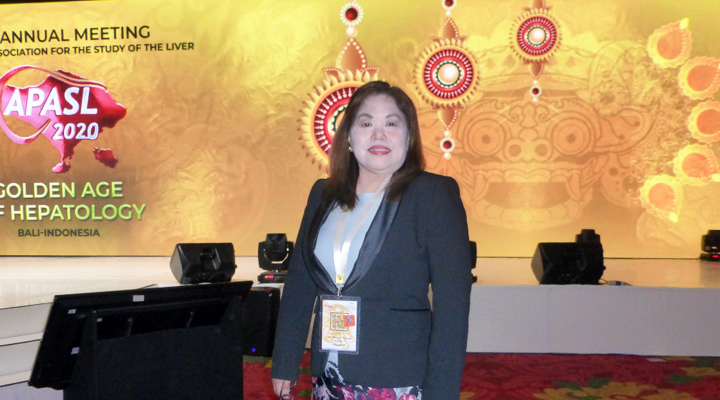
在肝癌患者对手术切除不耐受的情况下,消融技术可减少患者痛苦、延长患者生命周期、提高患者生活质量,受到广泛应用。常用的消融技术有射频消融和微波消融两种,它们各自有不同的特点,但在治疗时该如何选择呢?来听听亚太肝病学会(APASL)2019主席、菲律宾马尼拉圣桑托斯医疗中心Diana Payawal教授在第29届亚太肝病学会年会(APASL2020)现场接受《国际肝病》记者采访时的讲解。
tips:收听英文可以滑动文章学习英文呦!
1《国际肝病》:微波消融和射频消融在肝癌非手术治疗领域广泛应用。这两种方法有何相似和不同之处,谁更有优势?
Diana Payawal教授:二者相似之处在于它们都是利用物理热切除肿瘤。大多数肝癌是软性肿瘤,对极端的温度变化很敏感,包括加热(微波和射频)和冷却(冷冻疗法)。
其实,在2000年之前,临床都在使用乙醇化学消融治疗肝癌,后来才逐渐转向射频消融术。但是射频消融术还存在一些问题,该技术可产生纵向消融点,产生不均匀的消融区域,因此可能残留组织损伤,导致患者烧伤。
而微波消融是通过电极发出微波,通过电压改变瘤体内水分子的极性,微波升温快,消融范围也比较大。对于较大的肿瘤,微波治疗就足够了。但如果肿瘤临近胃肠道、胆囊旁等位置,微波消融需慎重。
两种技术都是目前先进的用于治疗肝癌的治疗手段,临床选择时需要根据医院自身专业技术水平和仪器条件以及患者经济水平综合考虑。
原文呈现:
<Hepatology Digest>: Microwave ablation and radiofrequency ablation have been widely used in the non-surgical treatment of liver cancer. What are the similarities and differences between the two methods?
Dr Payawal: The similarity is that they use heat to ablate the tumor. Most of the liver cancers are soft tumors, so they are sensitive to extremes of temperature, whether that is heating (microwaves and radiofrequency) or cooling (cryotherapy). In our country, we have also used chemical ablation using ethanol. Up until 2000, everyone was doing ethanol injections for liver cancer before practice graduated towards radiofrequency ablation (RFA), which uses thermal therapy and coagulation necrosis to burn the tumor. We find a lot of problems with it because it produces a longitudinal ablation point, has heterogeneous ablation areas so there is viable lesion remaining, and there can be grounding pads which can sometimes cause burns on patients. The ablation time is longer because it is increased gradually. For microwave ablation on the other hand, we can ablate the tumor homogenously in a spherical pattern (and most tumors are spherical in shape). We can ablate faster. We can perform a ten-minute ablation and therapy is done. And there are no grounding pads to potentially cause skin burns. Unlike RFA, there is a wider diameter of ablation with microwave therapy. What are the indications for each technique? For bigger tumors, microwave therapy would actually suffice. If the tumor is next to a blood vessel not involved in the tumor, the heat sink effect does not work, so it can ablate a tumor next to a vessel. Those are the similarities and differences.
《国际肝病》:晚期HCC患者的临床管理涉及多个学科。请您谈谈您所在中心的多学科管理经验?
Diana Payawal教授:在其他国家,微波消融和射频消融是在医院放射科进行,而我们中心什么都可以做,包括内窥镜检查、肝组织活检、消融治疗等等。但我们也会被安排将这些肝病治疗和管理的专业知识传授给其他非专业科室,这些情况变得越来越好。此外,肝癌的免疫治疗和靶向治疗也越来越引起关注。
原文呈现:
<Hepatology Digest>: The management of advanced HCC patients will involve a number of disciplines. Could you introduce your experience in the management of these patients using a multidisciplinary approach?
Dr Payawal: I was trained in a center where we do everything. We do endoscopy. We take care of liver cancer patients. We do our own liver biopsies. We do our own ablation therapy. In other countries, they do not have this expertise, so radiology teams actually come in for RFA and microwave procedures, and oncologists come in for oral chemotherapy. This is becoming less of a concern as we are being trained to tackle all aspects of liver disease and management. The emergence of immunotherapies and targeted therapy for liver cancer is of course now drawing a lot of attention as well.
《国际肝病》:想对未能来参会的《国际肝病》中国读者说些什么?
Diana Payawal教授:中国是一个肝病大国,我们一直在相互学习,很遗憾这次中国专家学者不能来参会,期待与他们一起讨论学术进展和挑战。我相信新型冠状病毒肺炎病例会越来越少,事实上它已经在中国发生了。虽然全球其他地方也出现了新病例,但中国似乎控制住了疫情,这一点非常值得赞扬。此外,我很惊讶地看到他们在几周内就建成了一座医院,这只可能发生在中国。所以,向中国参与控制疫情的战士们致敬。
原文呈现:
<Hepatology Digest>: The Hepatology Digest audience is Chinese hepatologists, and they cannot be here at the meeting. If you could address them, what words of encouragement would you share with them?
Dr Payawal: China has a lot of liver cancer patients. It is a two-way street, whereby we learn from them and they learn from us. We really miss them at APASL, and if they were here, we would be exchanging ideas on what is new and what they are doing in China, and what is new in other South-East Asian countries. We know that the coronavirus will start to decline, and indeed it already is in China. Although there are new cases elsewhere, China appears to have control of its epidemic, and kudos to the Chinese doctors for that. I was so surprised to see that they had constructed a hospital in a couple of weeks. That could only happen in China. So, hats off to the Chinese strategy for controlling the virus. I look forward to seeing our Chinese colleagues active at APASL again joining forces against liver disease. Infection is a big issue. We have just had the Presidential Lecture on bacterial infections, which is a growing concern in clinical practice. We have COVID, hepatitis B and C, and liver cancer as a progression of hepatitis. So this is something we can all work together on.